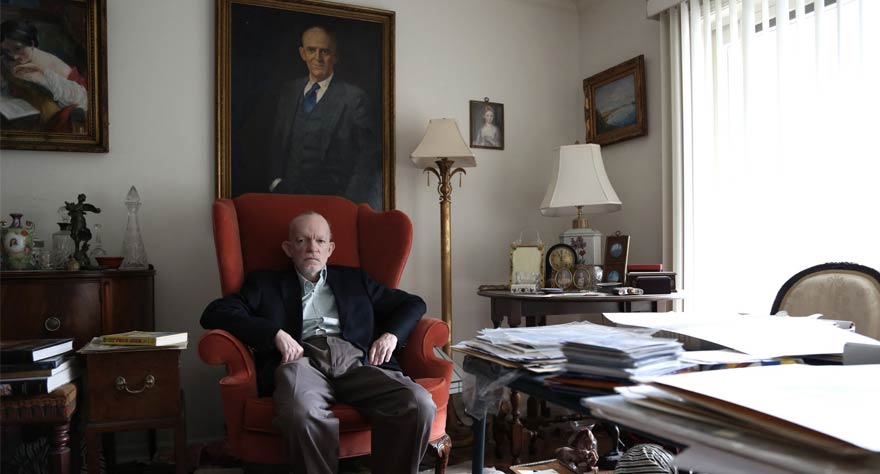
The documentary has several questions to answer, but only does a fair job directly answering them.

The documentary has several questions to answer, but only does a fair job directly answering them.
Hollywood is no stranger to stories involving criminal activity set in the art world. Dozens of titles populate movie history dating back to the early days of film and running as recently as George Clooney’s The Monuments Men (2014), with John McTiernan’s slick and scorching The Thomas Crown Affair (1999) as one of the sub-genre’s highlights. Now, from co-directors Sam Cullman, Jennifer Grausman, and Mark Becker, comes another art crime-related film entry, the documentary Art and Craft. However, it’s more than just its genre that makes the film unique – it’s also the actions of its subject, a master art forger.
Mark Landis is that master forger, but to look at him is not to be reminded of a smooth Hollywood criminal. With timid speech that complements his hunched shuffle and slight, withered frame, Landis looks closer to a retired librarian than he does to an art forger. Give him the supplies and a painting to replicate, though, and he’ll forge it. After creating the forgery, Landis assumes an alias, contacts any seemingly random museum, and passes off the forgery as the real thing. The peculiar catch, though, is that Landis doesn’t sell the painting to the museum – he simply donates it, usually in the name of a fictitious deceased person. Over the course of 30+ years, he’s pulled this act on almost four dozen museums in 20 states, with over 100 forgeries to his credit.
“In Sunday School they always tell everybody to make use of your gifts, you know? And copying pictures is my gift.” – Mark Landis
Once the story’s conceit is established, Art and Craft is a documentary that has several questions to answer, but it only does a fair job answering them directly. The question of why Landis does what he does is revealed gradually throughout the film. As this is a story of art and not psychology, it’s left to the viewer to “diagnose” Landis but, at least on the surface, his motivations and other circumstances are clear.
The next question involves why so many museums—many notable and located in major cities—have repeatedly accepted these forgeries without due diligence. There enters another important person in Landis’ story: Matthew Leininger. Leininger is an art expert and former museum registrar who was a recipient of a Landis forgery, but he was the first person to realize the art was fake. His is a significant tale here, because he is portrayed as something of a private investigator attempting to uncover all the forgeries and notify all the museums. This question of museums’ lack of due diligence is never answered directly, but a safe assumption is suggested that because museums aren’t asked for money, no protocol for art verification is in place. Think about it: who would try to pass off a fraud for no monetary gain? Surely the art must be real, right?
Is what Landis does illegal? This is answered by former FBI agent and founder of the FBI Art Crime Team, Robert Wittman. It’s an important question for more than just Landis—the documentarians follow Landis on several donation runs which raises questions about the filmmakers’ culpability in Landis’ actions.
The answer to the big-money question—how good is Landis at forging?—is glaringly absent and that absence is the film’s biggest flaw. Obviously the forger is very good at what he does because so many museums have accepted his work on sight. However, the filmmakers never make direct, side-by-side comparisons of original works and forgeries. Some originals are shown at certain points and some forgeries are shown at certain points, but not one moment says, “And here’s proof, even to your untrained eye, of how good Landis is at this.” Art is a visual medium; at least a cursory comparison would have sufficed.
The film’s other major flaw is its treatment of Leininger. While he is key to the story because of his dogged efforts to make other museums aware of Landis, he is presented as more than that. He’s drawn as that beleaguered guy in the movies who is the only one who sees the truth for what it is when everyone else is ambivalent towards the circumstances. The filmmakers fully develop Leininger’s back story, including the price he has paid for his crusade, and go so far as to include Leininger’s young child, who recognizes photos of Landis’ immediately, as if able to name the 50 states by their shapes. Leininger’s story and the framing of his obsession is so prevalent, it feels almost contrived, like the filmmakers simply didn’t have enough to fill a full doc on Landis, so they decided to pad the periphery with more Leininger. Other than Landis (of course), no other participant gets as much screen time or development as Leininger.
Still, Art and Craft‘s subject is fascinating to watch and listen to, whether copying artwork in his cluttered home or passing it off to another unsuspecting beneficiary, the latter of which is presented because the film was shot in real time, with events involving Landis unfolding as filming progressed. This makes the story engaging as its resolution, while technically already past, is presented as fresh.
Now available on DVD, VOD, and streaming.